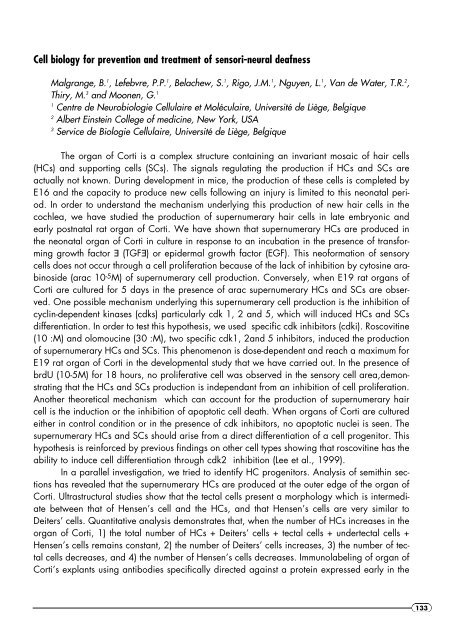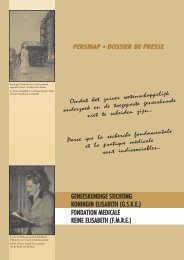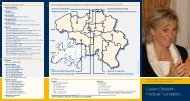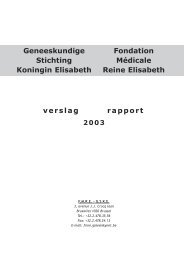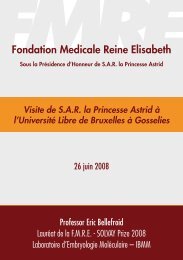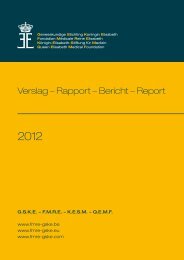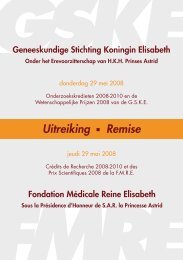Geneeskundige Stichting Koningin Elisabeth ... - GSKE - FMRE
Geneeskundige Stichting Koningin Elisabeth ... - GSKE - FMRE
Geneeskundige Stichting Koningin Elisabeth ... - GSKE - FMRE
Create successful ePaper yourself
Turn your PDF publications into a flip-book with our unique Google optimized e-Paper software.
Cell biology for prevention and treatment of sensori-neural deafness<br />
Malgrange, B. 1 , Lefebvre, P.P. 1 , Belachew, S. 1 , Rigo, J.M. 1 , Nguyen, L. 1 , Van de Water, T.R. 2 ,<br />
Thiry, M. 3 and Moonen, G. 1<br />
1 Centre de Neurobiologie Cellulaire et Moléculaire, Université de Liège, Belgique<br />
2 Albert Einstein College of medicine, New York, USA<br />
3 Service de Biologie Cellulaire, Université de Liège, Belgique<br />
The organ of Corti is a complex structure containing an invariant mosaic of hair cells<br />
(HCs) and supporting cells (SCs). The signals regulating the production if HCs and SCs are<br />
actually not known. During development in mice, the production of these cells is completed by<br />
E16 and the capacity to produce new cells following an injury is limited to this neonatal period.<br />
In order to understand the mechanism underlying this production of new hair cells in the<br />
cochlea, we have studied the production of supernumerary hair cells in late embryonic and<br />
early postnatal rat organ of Corti. We have shown that supernumerary HCs are produced in<br />
the neonatal organ of Corti in culture in response to an incubation in the presence of transforming<br />
growth factor ∃ (TGF∃) or epidermal growth factor (EGF). This neoformation of sensory<br />
cells does not occur through a cell proliferation because of the lack of inhibition by cytosine arabinoside<br />
(arac 10 -5M) of supernumerary cell production. Conversely, when E19 rat organs of<br />
Corti are cultured for 5 days in the presence of arac supernumerary HCs and SCs are observed.<br />
One possible mechanism underlying this supernumerary cell production is the inhibition of<br />
cyclin-dependent kinases (cdks) particularly cdk 1, 2 and 5, which will induced HCs and SCs<br />
differentiation. In order to test this hypothesis, we used specific cdk inhibitors (cdki). Roscovitine<br />
(10 :M) and olomoucine (30 :M), two specific cdk1, 2and 5 inhibitors, induced the production<br />
of supernumerary HCs and SCs. This phenomenon is dose-dependent and reach a maximum for<br />
E19 rat organ of Corti in the developmental study that we have carried out. In the presence of<br />
brdU (10-5M) for 18 hours, no proliferative cell was observed in the sensory cell area,demonstrating<br />
that the HCs and SCs production is independant from an inhibition of cell proliferation.<br />
Another theoretical mechanism which can account for the production of supernumerary hair<br />
cell is the induction or the inhibition of apoptotic cell death. When organs of Corti are cultured<br />
either in control condition or in the presence of cdk inhibitors, no apoptotic nuclei is seen. The<br />
supernumerary HCs and SCs should arise from a direct differentiation of a cell progenitor. This<br />
hypothesis is reinforced by previous findings on other cell types showing that roscovitine has the<br />
ability to induce cell differentiation through cdk2 inhibition (Lee et al., 1999).<br />
In a parallel investigation, we tried to identify HC progenitors. Analysis of semithin sections<br />
has revealed that the supernumerary HCs are produced at the outer edge of the organ of<br />
Corti. Ultrastructural studies show that the tectal cells present a morphology which is intermediate<br />
between that of Hensen’s cell and the HCs, and that Hensen’s cells are very similar to<br />
Deiters’ cells. Quantitative analysis demonstrates that, when the number of HCs increases in the<br />
organ of Corti, 1) the total number of HCs + Deiters’ cells + tectal cells + undertectal cells +<br />
Hensen’s cells remains constant, 2) the number of Deiters’ cells increases, 3) the number of tectal<br />
cells decreases, and 4) the number of Hensen’s cells decreases. Immunolabeling of organ of<br />
Corti’s explants using antibodies specifically directed against a protein expressed early in the<br />
133


